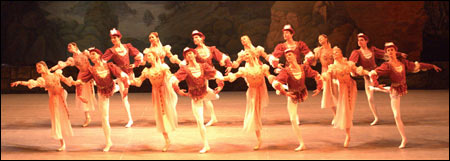The third act of Swan Lake is a ritual, signifying the transfer of royal power. The heir to the throne celebrates his coming of age, representatives of his future colonies pay him tribute, and he’s supposed to choose a bride. All this takes place in the presence of his mother the Queen and members of the court. In this quasi-public way the continuation of the monarchy will be ensured. Prince Siegfried has already fallen in love with an enchanted Swan, though, so after a round of waltzing with six would-be fiancées, he goes down the line and rejects each one.

HEARTY HUNTSMEN? TIPSY SERVING GIRLS? Not in this production. |
The way the Kirov Ballet performs this scene, the princesses are virtually identical partners in a formal dance. Only after they’ve been passed over does each react differently — one is disappointed, one huffily turns away. I bring this up because, as I think back over the performance Friday night at the Wang (sponsored by Bank of America Celebrity Series), it seems symptomatic of the Kirov’s whole style: Swan Lake down to the bone, all dancing with only the merest, conventionalized suggestion of acting verismo to create a plot. Everybody in it looks like his or her peer group, and all of them dance classical steps in strictly formal patterns with small inflections to indicate their station. The courtiers are a dutiful corps de ballet, the swans hop sorrowfully in arabesque, the Spanish women do deep backbends.
“Revised Choreography and Stage Direction” for the production are credited to Konstantin Sergeyev, and this explains a lot of its even tone. Sergeyev, who died in 1992, rechoreographed the 1895 Swan Lake in 1950, at the beginning of his nearly three decades as artistic director of the Kirov. We don’t know how many alterations have been made to Sergeyev’s reproduction, but it premiered deep in the Soviet period and still bears the respectful but revisionist attitude that brought the classics — scathed — through the Revolution.
The production looked choreographically credible to me but subtly sanitized. When the curtain went up on act one, the first thing you saw was dancing people wearing all-alike beige, white and mauve costumes in a generic ballet-Russian style, with the women in calf-length, high-waisted filmy dresses. No way to tell whether they’re villagers or gentry, friends or attendants. They dance neatly, drink toasts, dance some more.
While this is going on, the Prince’s Tutor (Petr Stasyunas) pulls two girls aside and introduces them to his charge. A bored playboy, Siegfried is polite but nothing more. The Tutor shrugs; he’s tried this before without success. After this promising piece of character sketching, the production forgoes even the pretext of psychological complexity and falls back on standard types, or no types at all.
Diana Vishneva, the Swan Queen Odette, projected exquisite despair throughout her second-act encounter with the Prince (Igor Kolb), and he looked stunned by her. In the third act he could do nothing but smile in goofy submission to her haughty glamor as the impostor Odile. I’m not saying they didn’t dance well. Vishneva unfolded tremendous extensions and beautiful pointe work, Kolb ripped off some lofty jumps. They looked really correct, and their every effect seemed really really studied.